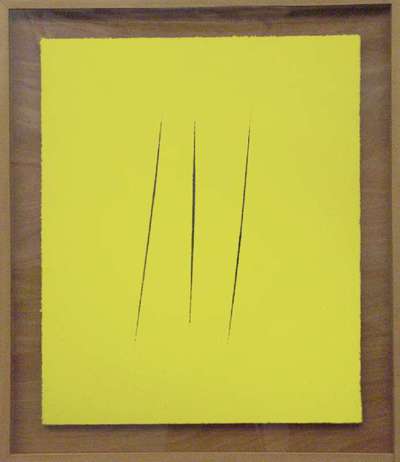Javascript must be enabled to continue!
Spatial Conception
View through Europeana Collections
Early in his career, Fontana, a sculptor’s son, had concentrated solely on sculpture. In 1948, he began puncturing and, later, slicing canvases, creating what he called Concetti spaziali (Spatial Conceptions). Freeing the canvas from its traditional, two-dimensional status, he formulated a new pictorial language, no longer attempting to create an illusion of space but actually creating space. The cuts (tagli), first executed in 1958, exemplify Fontana’s mature work. The surface is pure and monochromatic, but that purity is ruptured by the cuts that allow the void behind the canvas to penetrate the final work. As with the calligraphic strokes of East Asian ink paintings, the precise incisions were premeditated and irreversible. When viewing Fontana’s works, our mind reconstructs the strokes of the knife – a process of visualization that engenders a new aesthetic through destruction. As the artist himself once said, “As a painter working on one of my prepared canvases, I don’t want to make a picture, I want to open up space, to create a new dimension for art” (quoted in Jan van der Marck and Enrico Crispolti, Lucio Fontana, vol. 1 [Brussels, 1974], p. 7).
Title: Spatial Conception
Description:
Early in his career, Fontana, a sculptor’s son, had concentrated solely on sculpture.
In 1948, he began puncturing and, later, slicing canvases, creating what he called Concetti spaziali (Spatial Conceptions).
Freeing the canvas from its traditional, two-dimensional status, he formulated a new pictorial language, no longer attempting to create an illusion of space but actually creating space.
The cuts (tagli), first executed in 1958, exemplify Fontana’s mature work.
The surface is pure and monochromatic, but that purity is ruptured by the cuts that allow the void behind the canvas to penetrate the final work.
As with the calligraphic strokes of East Asian ink paintings, the precise incisions were premeditated and irreversible.
When viewing Fontana’s works, our mind reconstructs the strokes of the knife – a process of visualization that engenders a new aesthetic through destruction.
As the artist himself once said, “As a painter working on one of my prepared canvases, I don’t want to make a picture, I want to open up space, to create a new dimension for art” (quoted in Jan van der Marck and Enrico Crispolti, Lucio Fontana, vol.
1 [Brussels, 1974], p.
7).
Related Results
The Immaculate Conception
The Immaculate Conception
The Immaculate Conception entered the Collection in 1929. It was previously in the collection of Marczell von Nemes in Budapest. According to Heinemann the oldest known reference t...
Stained glass window from the Tarnów cathedral
Stained glass window from the Tarnów cathedral
Stained glass window depicting the Immaculate Conception of the Blessed Virgin Mary, made in the Tyrolean Mosaic and Stained Glass Works in Innsbruck (Tiroler Glasmalerei und Mosai...
Stained glass window from the Tarnów cathedral
Stained glass window from the Tarnów cathedral
Stained glass window depicting the Immaculate Conception of the Blessed Virgin Mary, made in the Tyrolean Mosaic and Stained Glass Works in Innsbruck (Tiroler Glasmalerei und Mosai...
J. Gutierrez de la Vega, la Conception de la Vierge. [Material gráfico]
J. Gutierrez de la Vega, la Conception de la Vierge. [Material gráfico]
Title and mention of responsibility in a strip stuck on the lower edge of the negative: "J. GUTIERREZ DE LA VEGA.- 578.- La Conception de la Vierge. J. Laurent. Madrid."...
Spatial Poem No. 2: A Flux Atlas
Spatial Poem No. 2: A Flux Atlas
This is a record of the second of Shiomi's international mail-art events, which began in 1965. Designed by George Maciunas, it is a map, accordion-folded in four panels, documentin...
The Water Stream, La Brème
The Water Stream, La Brème
“I also hold that painting is a quite concrete art, and can consist of nothing but the representation of real, tangible things, ” wrote Gustave Courbet in an open letter to his stu...




